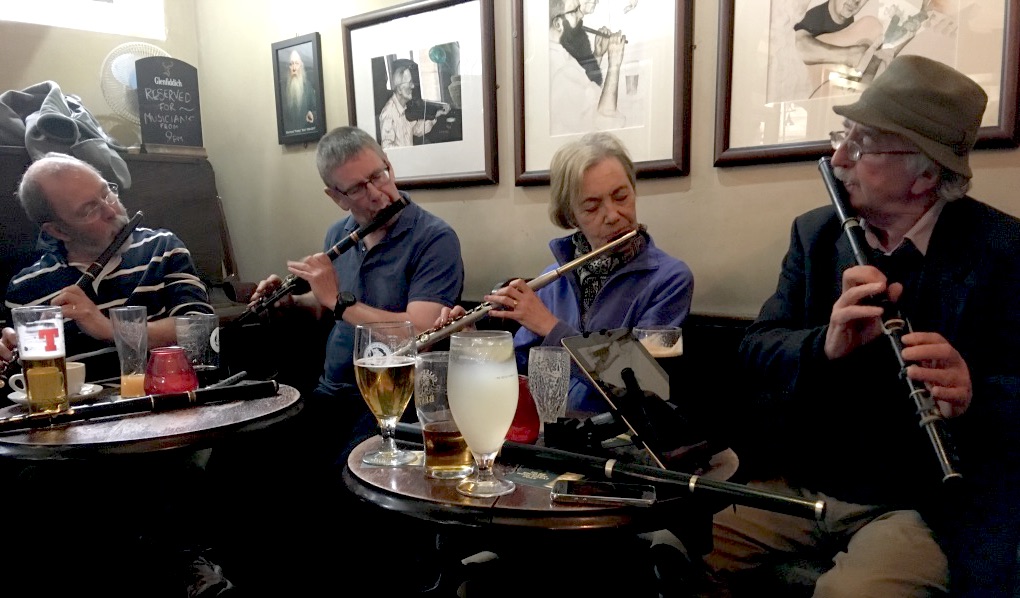FluteFling NE Tunebook Project: 08 The Bonnie Lass o’ Fyvie/ The 72nd Highlanders’ Farewell to Aberdeen (The Little Boy’s Lament for his Dragon) (4/4 March Set)
This eighth video in the series features two popular marches with Aberdeenshire titles.
For background to the project of 10 sets of tunes being recorded over 10 weeks, and to see the first video, start here. Alternatively, go straight to the videos on my Youtube channel.
You can download the free PDF of the sheet music here:
FluteFling Aberdeen 2019 NE Scotland Tunes
The Bonnie Lass o’ Fyvie/ The 72nd Highlanders’ Farewell to Aberdeen
FluteFling NE Tunebook Project: The Bonnie Lass o’ Fyvie/ The 72nd Highlanders’ Farewell to Aberdeen (The Little Boy’s Lament for his Dragon)
This eighth video in the series features two marches with Aberdeenshire names. These are from the FluteFling NE Tunebook of Scottish session tunes for flute and whistle and I play these on my Rudall and Rose 8-keyed flute and Eamonn Cotter keyless flute, both in D.
The Bonnie Lass o’ Fyvie
The Bonnie Lass o’ Fyvie is the melody to a traditional song that has travelled far and wide, into Scottish, Irish, English and American traditions. It begins:
There once was a troop o’ Irish dragoons
Cam marching doon through Fyvie-o
And the captain’s fa’en in love wi’ a very bonnie lass
And her name it was ca’d pretty Peggy-o
The song may possibly have its origins in the 1600s, according to one theory. With many variations of words, places and names, the versions have been recorded multiple times by a wide range of musicians, singers and artists. For a full breakdown, see this Wikipedia entry.
Many songs have ended up being pipe marches for the simple reason that the soldiers would know the words and could sing them as they marched, boosting morale and helping to keep an even and sustainable marching pace. The words give a sense of the rhythm and pace at which to play the march.
This version of the song by Aberdeenshire’s Old Blind Dogs is one of many fine recordings of the song to be found on YouTube.
The setting in the tune book is in G but drops down to low C natural, so keys will be required. However, it is possible to to play the C natural an octave higher and I demonstrate both of these options. A third option is to play the entire tune an octave higher than is written. I didn’t think of this until after the recording so that option doesn’t appear in the video.
The setting probably suits accordions and fiddles better than flutes and whistles and may be common in NE Scotland sessions. A way around this is to transpose the tune into D. A version in that key can be found on The Session website.
The tune has just one part so might be played many times rather than a number standard to the session you are playing in. In a FluteFling session, playing the tune 4 times would be reasonable, depending on the session dynamics.
The 72nd Highlanders’ Farewell to Aberdeen (The Little Boy’s Lament for his Dragon)
This Highland bagpipe march was probably written by William McKay in 1876, who called it The Little Boy’s Lament for his Dragon, “dragon” meaning “kite”. It acquired its Aberdeen title probably around 1885, and knowledge of the authorship become blurred.
There’s a lengthy discussion on this tune, its authorship, titles, versions and the perils of reading bagpipe music on The Session. With some fine voices such as Kenny Hadden and Nigel Gatherer contributing, it is worth a read.
See The Traditional Tune Archive for a very helpful note on this too.
I originally learned and played a different setting of this tune, one with C naturals and some of the snaps reversed (see that discussion in The Session). Be aware when playing to adapt to the majority of those you are playing with, or, often more importantly, to the person leading that particular set of tunes. Both are good session courtesies.
It’s a reminder that when playing, listening happens on many levels, not just to the performances of the other musicians, but to their versions, their pace and the different demands of their instruments.
Ten weeks of videos
Over a 10 week or so period, I am recording and uploading to YouTube a set of tunes from the PDF roughly once a week. The aim is to introduce the tunes, point out some techniques along the way and then play them as a set as I might play them in a session.
As I go along, I’ll take in suggestions to improve the sound and presentation and get back into the way of teaching again. There is an in-built slow down function in YouTube and the PDF is available to everyone, so why not join me on the journey?

